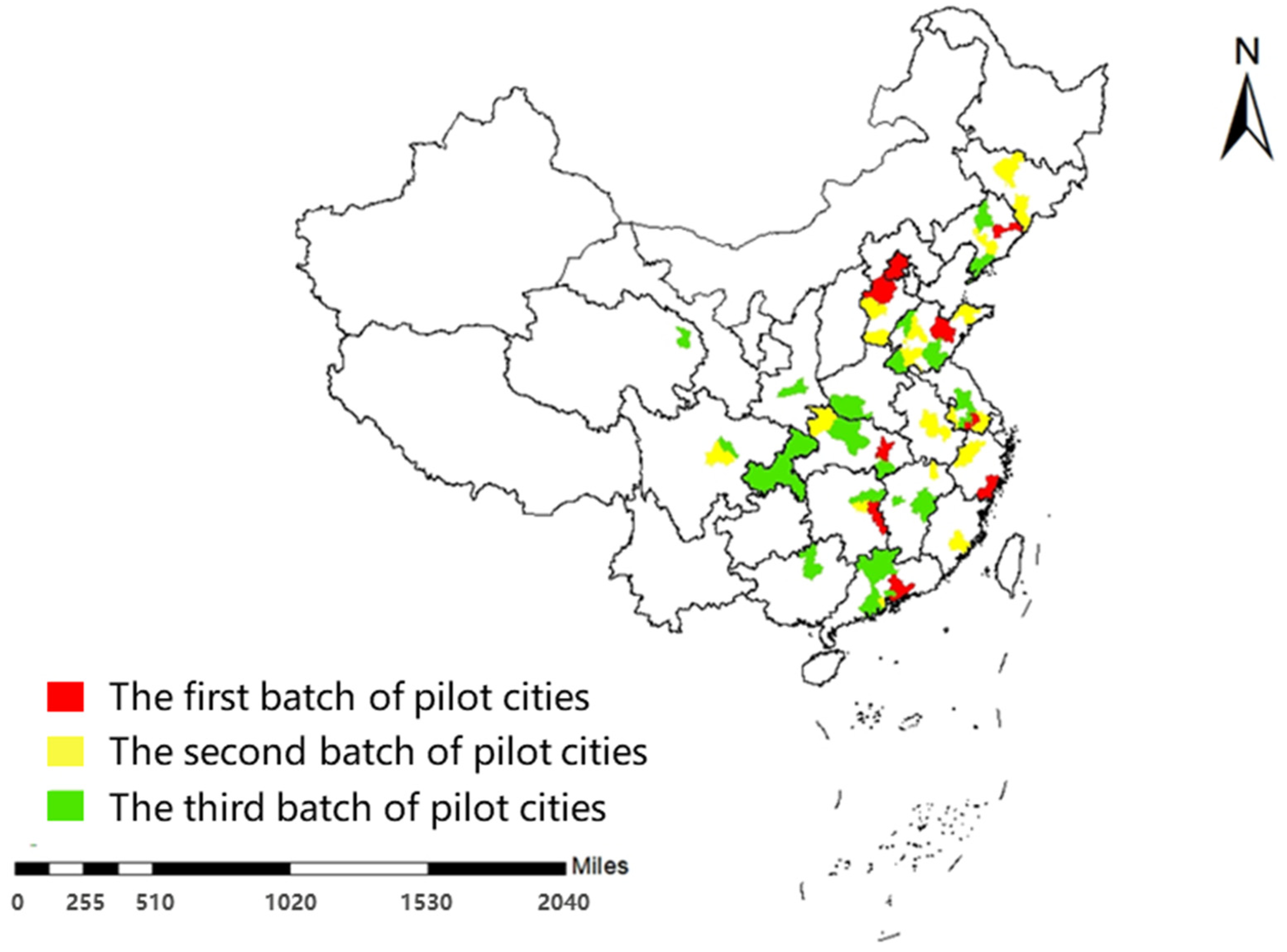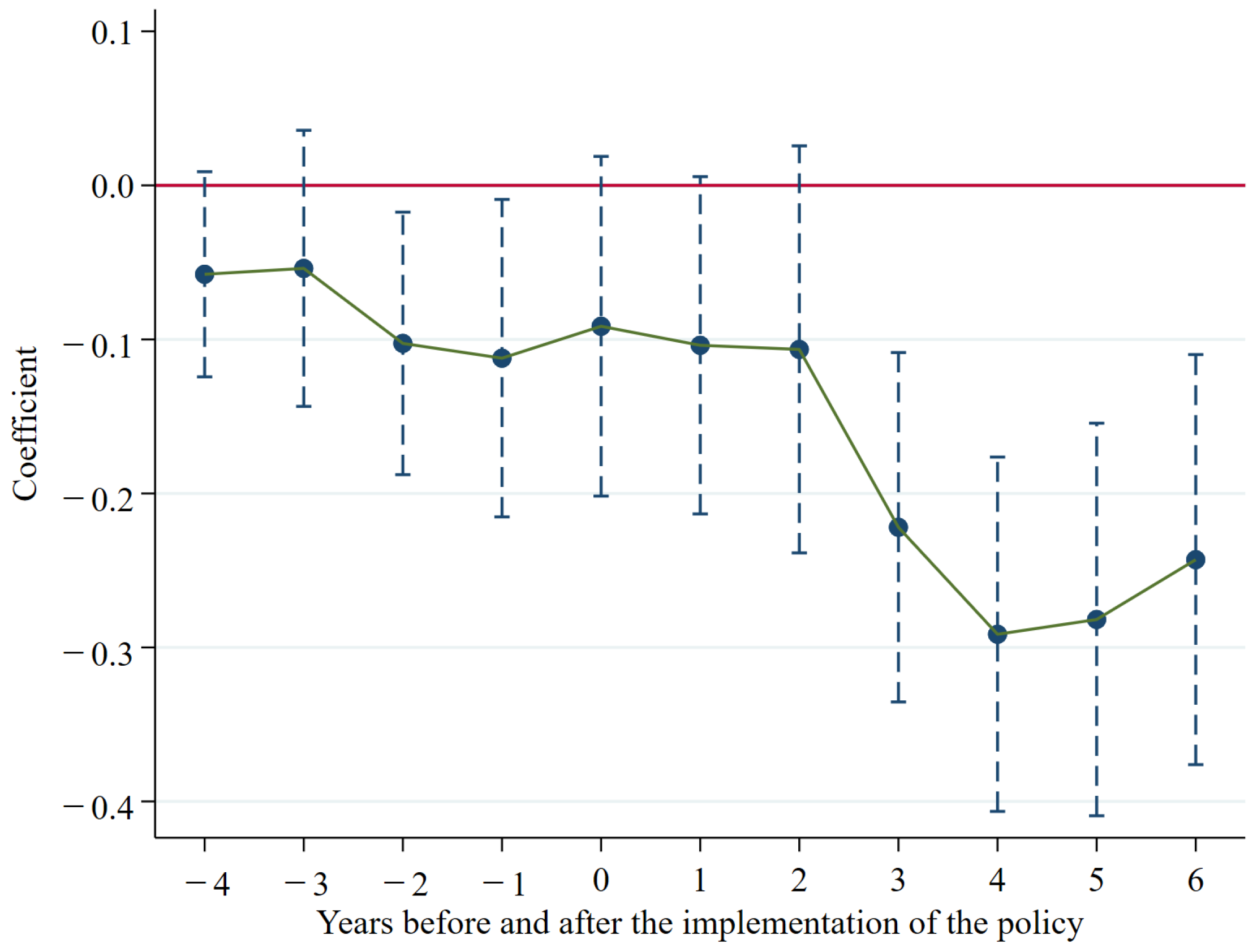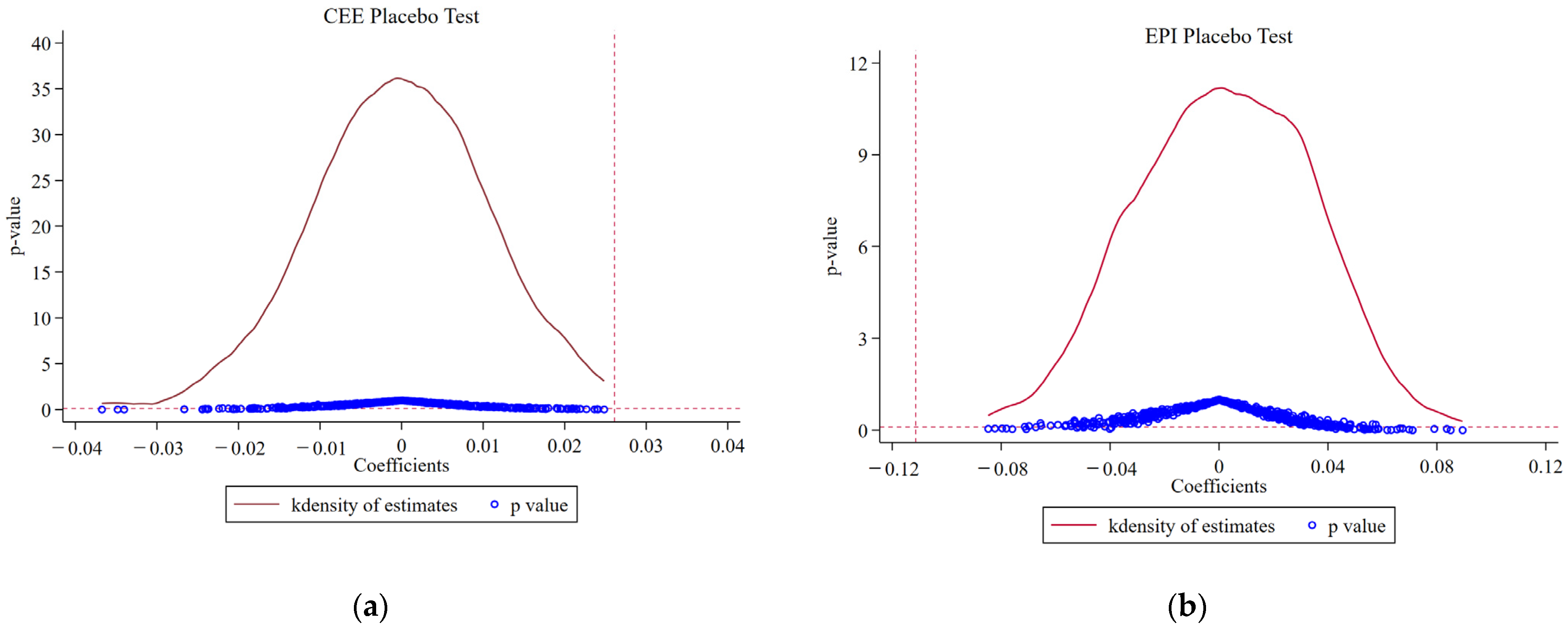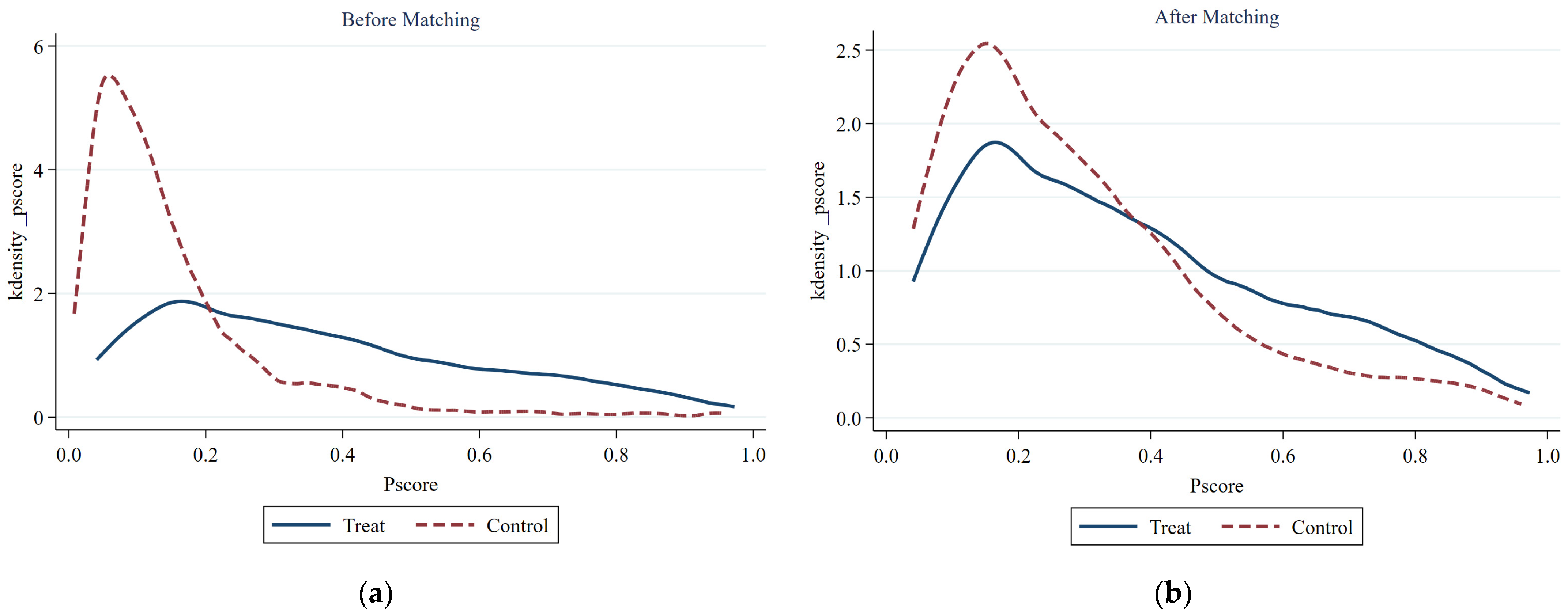1. Introduction
The advancement of informatization, the rapid growth of biotechnology, and the Internet are changing the economic production pattern and market structure [
1]. Scientific and technological innovation is spreading to all fields of society and gradually becoming the main driving force of global economic development. In recent years, the United States, Germany, Japan, Russia, and other countries have launched national innovation strategies, which regard innovation ability as the core of comprehensive national strength competition [
2]. Similarly, in China, innovation-driven development has become the new trend in economic development [
3]. Accelerating the cultivation of innovative industries has already been a strategy for China’s economic development [
4]. Based on the traditional industrial agglomeration, innovation industrial agglomeration emphasizes agglomeration development with innovation as the core [
5]. It refers to the gathering of enterprises, R&D, and service institutions related to the industrial chain in a specific region to form a cross-industry and cross-regional industrial organization form through a division of labor and cooperation, and collaborative innovation. The IIAP is focused on high-tech and strategic new industries. Since the Ministry of Science and Technology of China officially started to implement the first batch of innovative industrial agglomeration pilots (IIAP) in 2013, China attached importance to its development and then gradually expanded the pilot scope in 2014 and 2017. By 2020, China had gradually laid out 48 innovative industrial agglomeration pilot construction units and 61 innovative industrial agglomeration pilot units, involving 55 prefecture-level cities.
Unlike traditional industrial agglomeration, innovative industrial agglomeration gathers more innovative enterprises in a particular geographical area. The phenomenon of agglomeration can push the integration of industrial resources, optimize the upgrading of industrial structure and, thus, promote economic growth [
6]. At the same time, the agglomeration development will use a large number of internal and external resources in the agglomeration area, leading to excessive centralization of population, which will also bring different levels of influence to the surrounding environment [
7]. China is a major carbon emitter and is under greater pressure to save energy and reduce emissions in economic development [
8]. Therefore, it has become an essential requirement for China’s development to implement green transformation, to undertake green and low-carbon energy development, and to adhere to the development path of ecological priority [
9]. As a vital combination of China’s innovation strategy and industrial agglomeration development, the IIAP plays a vital role in enhancing industrial innovation capability and regional economic development. However, it remains to be further verified whether the IIAP will bring different impacts on the internal and external environment of the cluster region while promoting industrial economic development.
Industrial agglomeration is a form of spatial organization based on the depth of labor division. It is essential for the optimization of resource allocation and stimulating enterprise innovation through knowledge spillover and incremental returns to scale [
10]. Moreover, theoretical studies related to new geography economics suggested that technology externalities and knowledge spillovers are the main impetus for enterprise innovation in agglomeration regions [
11]. At the same time, technological advancement and increased innovation levels play a crucial role in pollution control [
12]. The industry provides a collaborative innovation environment for enterprises in the agglomeration area through technology spillover, which enhances the efficiency of clean technology R&D and promotes pollution reduction [
13]. Therefore, industrial agglomeration and emission reduction may be intrinsically linked. Furthermore, the impact of industrial agglomeration on the environment has received interest from scholars. Quite a few studies have revealed that industrial agglomeration significantly promotes carbon emissions [
14]. In contrast, some scholars also believe that industrial agglomeration inhibits carbon emissions [
15]. Similarly, a few studies show a nonlinear relationship with carbon emissions [
16]. First, the IIAP is to enhance the innovation development of high technology enterprises through policy incentives. Under the stimulus of the policy, the local government will play a leading function and bring in more resource elements, thus, providing a good environment for the implementation of the IIAP. Second, the sources of pollution emissions should be measured comprehensively. Under the government’s guidance, industrial agglomeration can increase energy utilization [
17]. Labor concentration can also cause excessive consumption of raw materials and wastewater discharge [
18]. Therefore, the impact of agglomeration on the environment cannot be achieved simply by carbon emissions, but also by considering major environmental pollutants, such as sulfur dioxide, soot, wastewater, PM2.5, etc. In addition, the impact of the IIAP on the environment may have a spatial effect. Since the implementation of the IIAP, the number of pilot units has been increasing, and the area involved has been gradually expanded. The natural resources of neighboring cities are similar [
19]. The technology and innovation brought to the local area by the IIPA can be copied and learned from by neighboring cities. They may also have some impact on the surrounding environment. Therefore, whatever the effect of the IIAP on the environment, it can be studied by neighboring regions, which can contribute to the promotion of ecological efficiency levels and contribute to environmentally-friendly development.
This paper explores the impact of the innovative industrial agglomeration pilot (IIAP) policy on the environment and conducts in-depth analysis of carbon efficiency and the environmental pollution index. Specific contributions are as follows: first, from the existing research, work on pilot policies and the environment have made remarkable achievements in other pilot policies, such as the low-carbon pilot and innovative city pilot. However, there have been relatively few studies on the innovative industrial agglomeration pilot policy. Hence, this paper selects the IIAP to further examine the impact of the IIAP policy on the environment. Second, when existing studies measure the impact of the pilot policy on the environment, most of them only analyze from the perspective of carbon emissions. In contrast, this paper comprehensively examines the impact of the IIAP on the environment. We construct an environmental pollution index using the primary environmental pollutants sulfur dioxide, wastewater, soot, and PM2.5, and examine the carbon emissions efficiency and the environmental pollution index. Finally, our study constructs a spatial DID model to further investigate the spatial effects of the IIAP.
The structure of this paper is as follows.
Section 2 reviews the literature on the IIAP and environmentally-friendly development and puts forward the research hypothesis of this paper.
Section 3 introduces the data sources and variable definitions, and then establishes the multi-period difference-in-difference (DID) model and mediating effect model.
Section 4 reports the empirical results and data analysis.
Section 5 explores spatial spillover effect of the IIAP using spatial DID.
Section 6 draws conclusions, makes relevant policy recommendations, and presents the shortcomings and outlook of this paper.
6. Conclusions and Discussion
Since the innovation industrial agglomeration pilot (IIAP) policy was proposed in 2013, the range of the pilot has been continuously expanded. On the one hand, the pilot policy stimulates the innovation and development of enterprises; on the other hand, the pilot policy takes the government as the main body. The local government will play a guiding and supervisory role. With regular accessing of the work progress, problems, such as difficulties in resource flow, excessive consumption of raw materials, and increased pollutant emissions encountered during the development of innovative industrial agglomeration, can be solved in time. This study explores the effect of the IIAP on the environment through carbon efficiency and the environmental pollution index. We further develop an in-depth analysis using technological innovation as a mediating variable.
We conclude that the IIAP policy can promote environmentally-friendly development. On the one hand, the implementation of the IIAP policy gathers a large number of high-tech talents and technologies, which can raise the utilization efficiency and reduce emission pollutants. On the other hand, the policy guidance of industrial agglomeration is also a characteristic of China’s development in the agglomeration industry. Behind the implementation of the policy is the government, which supervises the enterprises in the agglomeration area, knows the work situation, and solves the pollution problems in the process of innovation in time. Industrial agglomeration in a particular geographical area is conductive to the centralized disposal of discharged pollutants. Therefore, the IIAP policy can promote environmentally-friendly development. Second, the IIAP policy can indirectly promote environmental-friendly development through technological innovation. Innovative industry agglomeration is knowledge-intensive and technology-intensive and, thus, attracts high-skilled talents. In turn, it improves the technological innovation of enterprises and promotes the efficiency of clean energy research and development, which in turn has a positive effect on environmental. Third, the effect of the IIAP policy on environmentally-friendly development is mainly in the central region, non-resource-based cities, and large cities, with obvious regional differences in distribution. Fourth, there is a spatial siphon effect of the IIAP policy on the environmental pollution index (EPI). The IIAP policy can provide excellent conditions for agglomeration areas and attract the inflow of talents and innovation factors from the surrounding areas. Therefore, it will lead to a decrease in technological innovation in the neighboring areas, which will be detrimental to the environmental improvement in the neighboring areas in the short term.
Our results lead to the following policy implications. Firstly, the government should continue to maintain the steady growth of the pilot units of innovative industrial agglomeration. The IIAP policy has achieved positive effects on environmentally-friendly development. To advance the social effect of the IIAP policy on the environment, the Ministry of Science and Technology of China should steadily promote the construction of innovative industrial agglomeration. It should reasonably plan the cultivation of pilot industries. In the meantime, it should advance the opening of pilot cities in an active and orderly manner, accelerate the development of innovative industries, and contribute to environmentally-friendly development. Secondly, it should actively promote technological innovation capability in the agglomeration region. The local government should further play the leading role in this pilot policy, and adopt tax incentives, financial subsidies, and other forms to actively encourage enterprises to gather innovative technologies and talents. The development of technological innovation level can be accelerated, and the resource utilization efficiency and pollution control rate can be improved, in consequence. Finally, it should optimize the spatial layout of innovative industrial agglomeration. The promotion of the IIAP cities should advocate the development strategy suitable for local conditions, thoroughly combine and utilize the advantages of resources inside and outside the region, and better promote environmentally-friendly development.
Our study must be considered in light of several limitations. Firstly, compared with the low-carbon pilot policy, smart cities pilot policy, and other policies, the IIAP policy in China is not deeply understood by the public. Although the regional scope of the pilot unit has been expanding since its implementation, it still needs to be improved compared with other policies. Secondly, the impact of the IIAP policy on the environment may be through technological innovation, industrial structures, and financial development, etc. This paper examines the effect of the IIAP policy on the environment by using technological innovation as a mediating variable. Technological innovation only serves as a resource transmission path, so a more extensive framework should be constructed in future research to conduct a more profound analysis.













